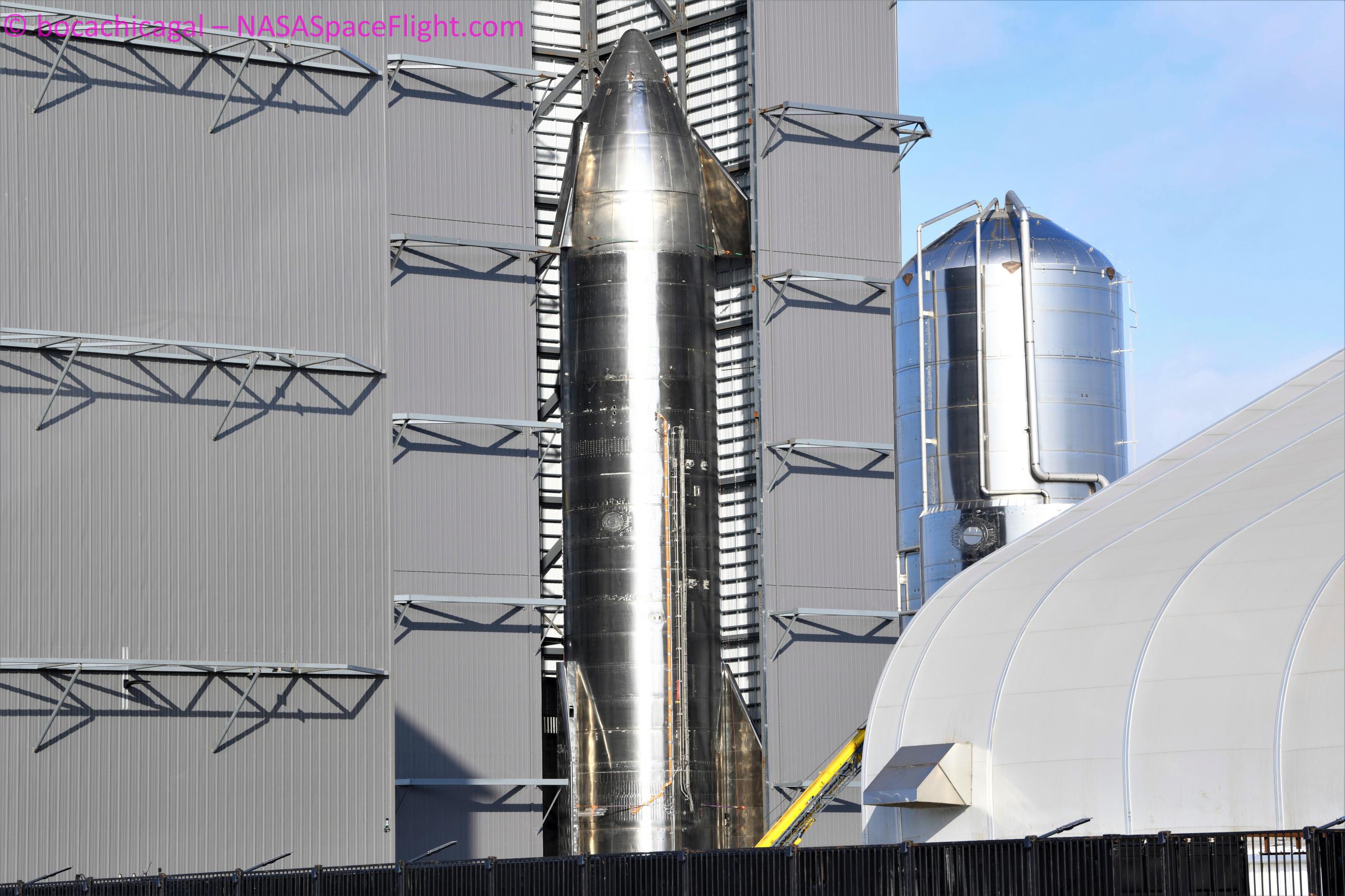
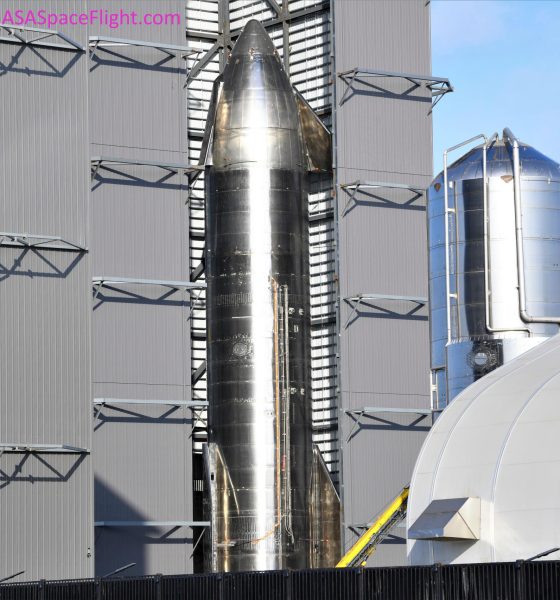
News
SpaceX starts stacking Starship’s first orbital-class Super Heavy booster
By all appearances, SpaceX has begun the process of stacking what could become the first Super Heavy booster capable of supporting orbital Starship test flights.
Known as booster number 3 (BN3), numerous sections of the 70-meter-tall (230 ft) steel rocket have been spotted at SpaceX’s Boca Chica, Texas factory over the last six or so weeks – adding up to a substantial portion of what is now expected to be the first flightworthy Super Heavy. Earlier this year, SpaceX stacked Super Heavy BN1 to its full height but late design changes effectively rendered the prototype largely irrelevant and turned it into more of a manufacturing pathfinder and source of practice than anything else.
As a result, BN1 never even left the high bay it was built in before SpaceX workers cut the booster into scrap. As of May, while a handful of parts for booster number 2 have been spotted, signs indicate that BN2 will be turned into a small test tank to qualify Super Heavy’s complex and unproven thrust dome and engine section.
That leaves Super Heavy BN3. According to NASASpaceflight.com, SpaceX has nominally assigned booster BN3 to support Starship SN20 on its inaugural space launch attempt. Just last week, SpaceX filed an application with the FCC for permission to communicate with Starship and Super Heavy during that “orbital test flight” – paperwork that included a six-month launch window scheduled to open no earlier than June 20th.
If approved by the FCC and – far more importantly – the FAA, Starship’s first “orbital test flight” will circumnavigate three-quarters of the world in approximately 90 minutes, launching from Boca Chica and ending – if all goes well – with Starship SN20 gently splashing down near Kauai, Hawai’i. From the sparse documentation SpaceX included in the public application, it’s ambiguous if there will be an attempt to recover Super Heavy booster BN3 or if the test flight will actually be orbital, given that Starship SN20 wont complete a full orbit.
Technically speaking, although a Starship capable of safely launching from Texas to Hawai’i is almost unequivocally capable of reaching orbit, the safest possible “orbital” flight test for such a massive spacecraft would stop just shy of orbit. A guaranteed free-return reentry would make it almost impossible for Starship to reach orbit, fail to deorbit after its first ~90 minutes in space, and end up posing a risk to populated areas – like, say, the now-infamous boosters of China’s Long March 5B rocket. Regardless, it’s clear that the specifics of Starship’s first spaceflight attempt are still very much up in the air and liable to change over the next few weeks.
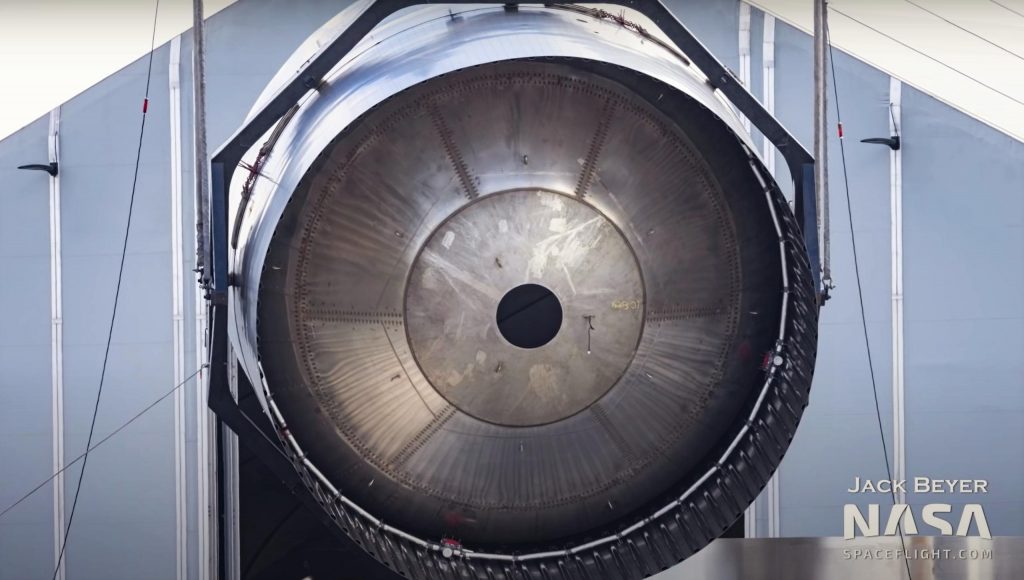
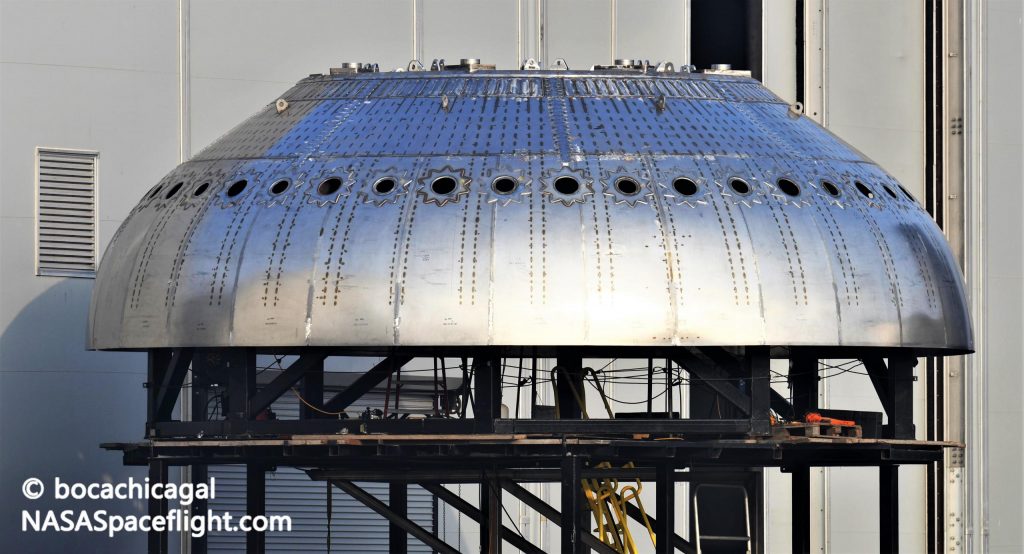
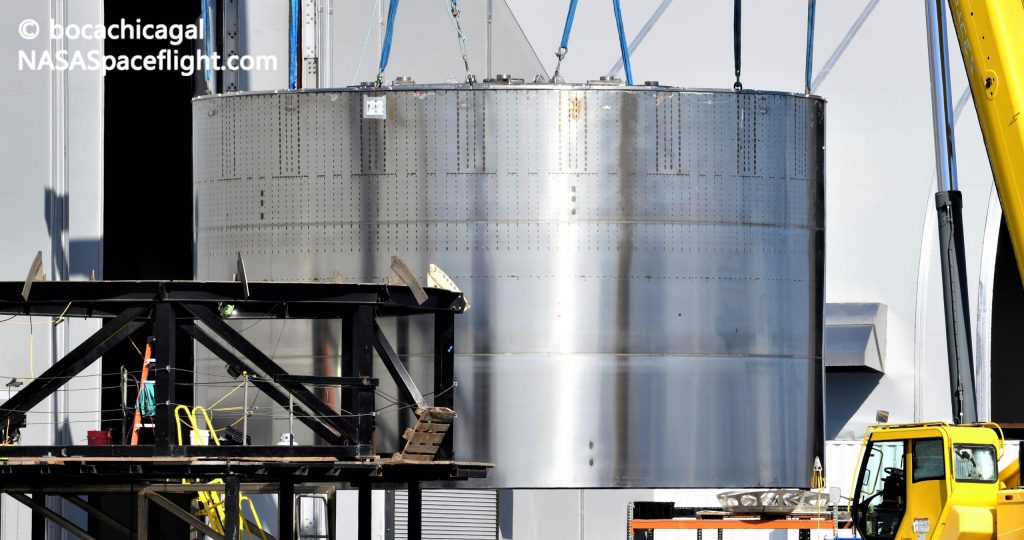
What isn’t up in the air is the fact that SpaceX will need to all but fully assemble and test Super Heavy booster BN3 and Starship SN20 before any potential space shot. Along those lines, SpaceX still has a huge amount of work to do. Per Twitter user Brendan Lewis’ accounting, SpaceX has at least six BN3 sections – amounting to 22 rings and two of three tank domes – either completed or awaiting integration. The process of stacking BN3 began sometime in the last 7-10 days when SpaceX joined two four-ring sections – including the booster’s common dome, likely pictured above.
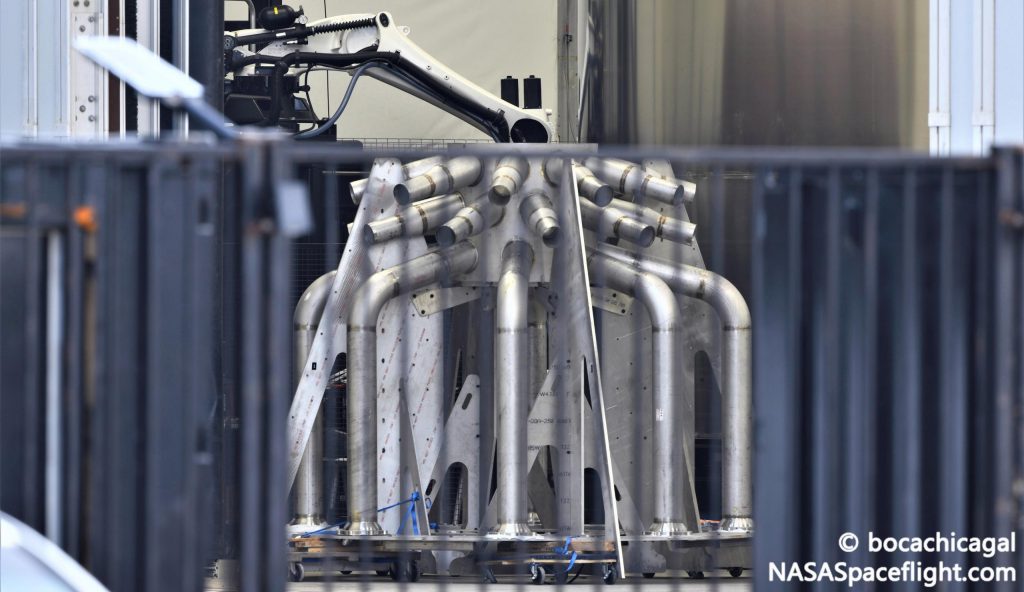
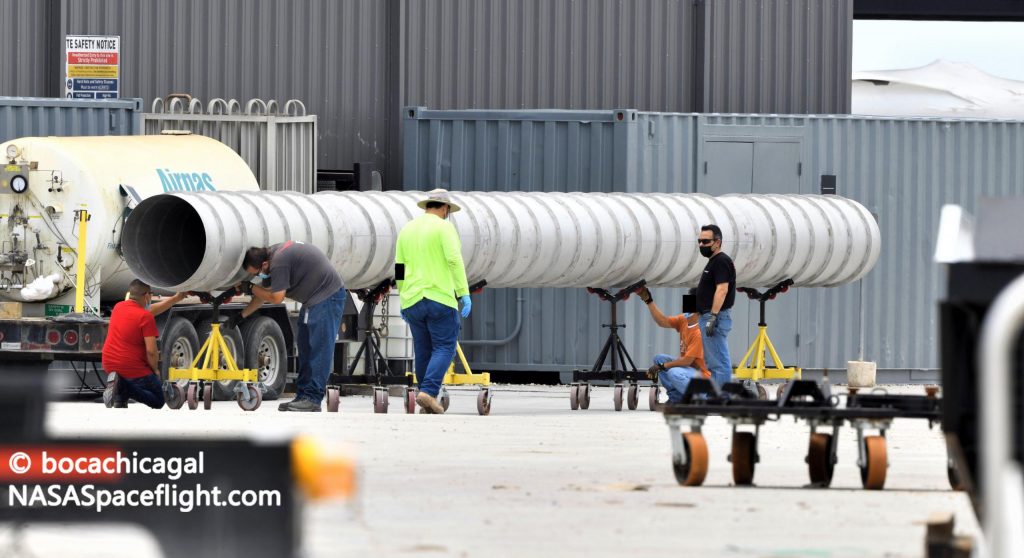
SpaceX has mostly completed BN3’s engine section, including a thrust dome with plumbing cutouts for a full 28 Raptor engines. Most recently, what looks like a Super Heavy fuel manifold appeared in Boca Chica. That manifold will attach to the end of a supersized Super Heavy transfer tube – also spotted in work – used to route methane through the liquid oxygen tank to fuel its Raptor engines. Fueling 28 large, high-performance Raptors is no mean feat and requires a rat’s nest of plumbing to feed them more than 15 metric tons (~30,000 lb) of propellant every second at full throttle.
Put simply, a majority of Super Heavy booster BN3’s hardware appears to be ready or almost ready for integration. The eight rings now stacked represent approximately 20% of the rocket’s full height, leaving another 30 or so rings – 54m (~180 ft) – to go. Given how long BN1 assembly took SpaceX, the company has its work cut out for it to fully integrate BN3 by June 20th, and the first operational Super Heavy prototype will almost certainly need to complete several major tests before being cleared for flight. As such, an inaugural space launch attempt in June or July is wildly implausible, but it’s far from out of the question that Starship and Super Heavy could be ready for their first “orbital test flight” before summer turns to fall.

News
Elon Musk’s Grokipedia surges to 5.6M articles, almost 79% of English Wikipedia
The explosive growth marks a major milestone for the AI-powered online encyclopedia, which was launched by Elon Musk’s xAI just months ago.

Elon Musk’s Grokipedia has grown to an impressive 5,615,201 articles as of today, closing in on 79% of the English Wikipedia’s current total of 7,119,376 articles.
The explosive growth marks a major milestone for the AI-powered online encyclopedia, which was launched by Elon Musk’s xAI just months ago. Needless to say, it would only be a matter of time before Grokipedia exceeds English Wikipedia in sheer volume.
Grokipedia’s rapid growth
xAI’s vision for Grokipedia emphasizes neutrality, while Grok’s reasoning capabilities allow for fast drafting and fact-checking. When Elon Musk announced the initiative in late September 2025, he noted that Grokipedia would be an improvement to Wikipedia because it would be designed to avoid bias.
At the time, Musk noted that Grokipedia “is a necessary step towards the xAI goal of understanding the Universe.”
Grokipedia was launched in late October, and while xAI was careful to list it only as Version 0.1 at the time, the online encyclopedia immediately earned praise. Wikipedia co-founder Larry Sanger highlighted the project’s innovative approach, noting how it leverages AI to fill knowledge gaps and enable rapid updates. Netizens also observed how Grokipedia tends to present articles in a more objective manner compared to Wikipedia, which is edited by humans.
Elon Musk’s ambitious plans
With 5,615,201 total articles, Grokipedia has now grown to almost 79% of English Wikipedia’s article base. This is incredibly quick, though Grokipedia remains text-only for now. xAI, for its part, has now updated the online encyclopedia’s iteration to v0.2.
Elon Musk has shared bold ideas for Grokipedia, including sending a record of the entire knowledge base to space as part of xAI’s mission to preserve and expand human understanding. At some point, Musk stated that Grokipedia will be renamed to Encyclopedia Galactica, and it will be sent to the cosmos.
“When Grokipedia is good enough (long way to go), we will change the name to Encyclopedia Galactica. It will be an open source distillation of all knowledge, including audio, images and video. Join xAI to help build the sci-fi version of the Library of Alexandria!” Musk wrote, adding in a later post that “Copies will be etched in stone and sent to the Moon, Mars and beyond. This time, it will not be lost.”
News
Tesla Model 3 becomes Netherlands’ best-selling used EV in 2025
More than one in ten second-hand electric cars sold in the country last year was a Tesla Model 3.

The Tesla Model 3 became the most popular used electric car in the Netherlands in 2025, cementing its dominance well beyond the country’s new-car market.
After years at the top of Dutch EV sales charts, the Model 3 now leads the country’s second-hand EV market by a wide margin, as record used-car purchases pushed electric vehicles further into the mainstream.
Model 3 takes a commanding lead
The Netherlands recorded more than 2.1 million used car sales last year, the highest level on record. Of those, roughly 4.8%, or about 102,000 vehicles, were electric. Within that growing segment, the Tesla Model 3 stood far ahead of its competitors.
In 2025 alone, 11,338 used Model 3s changed hands, giving the car an 11.1% share of the country’s entire used EV market. That means more than one in ten second-hand electric cars sold in the country last year was a Tesla Model 3, Auto Week Netherlands reported. The scale of its lead is striking: the gap between the Model 3 and the second-place finisher, the Volkswagen ID3, is more than 6,700 vehicles.
Rivals trail as residual values shape rankings
The Volkswagen ID.3 ranked a distant second, with 4,595 used units sold and a 4.5% market share. Close behind was the Audi e-tron, which placed third with 4,236 registrations. As noted by Auto Week Netherlands, relatively low residual values likely boosted the e-tron’s appeal in the used market, despite its higher original price.
Other strong performers included the Kia Niro, the Tesla Model Y, and the Hyundai Kona, highlighting continued demand for compact and midsize electric vehicles with proven range and reliability. No other model, however, came close to matching the Model 3’s scale or market presence.
News
Tesla Model Y Standard Long Range RWD launches in Europe
The update was announced by Tesla Europe & Middle East in a post on its official social media account on X.

Tesla has expanded the Model Y lineup in Europe with the introduction of the Standard Long Range RWD variant, which offers an impressive 657 km of WLTP range.
The update was announced by Tesla Europe & Middle East in a post on its official social media account on X.
Model Y Standard Long Range RWD Details
Tesla Europe & Middle East highlighted some of the Model Y Standard Long Range RWD’s most notable specs, from its 657 km of WLTP range to its 2,118 liters of cargo volume. More importantly, Tesla also noted that the newly released variant only consumes 12.7 kWh per 100 km, making it the most efficient Model Y to date.
The Model Y Standard provides a lower entry point for consumers who wish to enter the Tesla ecosystem at the lowest possible price. While the Model 3 Standard is still more affordable, some consumers might prefer the Model Y Standard due to its larger size and crossover form factor. The fact that the Model Y Standard is equipped with Tesla’s AI4 computer also makes it ready for FSD’s eventual rollout to the region.
Top Gear’s Model Y Standard review
Top Gear‘s recent review of the Tesla Model Y Standard highlighted some of the vehicle’s most notable features, such as its impressive real-world range, stellar infotainment system, and spacious interior. As per the publication, the Model Y Standard still retains a lot of what makes Tesla’s vehicles well-rounded, even if it’s been equipped with a simplified interior.
Top Gear compared the Model Y Standard to its rivals in the same segment. “The introduction of the Standard trim brings the Model Y in line with the entry price of most of its closest competition. In fact, it’s actually cheaper than a Peugeot e-3008 and costs £5k less than an entry-level Audi Q4 e-tron. It also makes the Ford Mustang Mach-E look a little short with its higher entry price and worse range,” the publication wrote.








